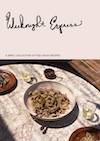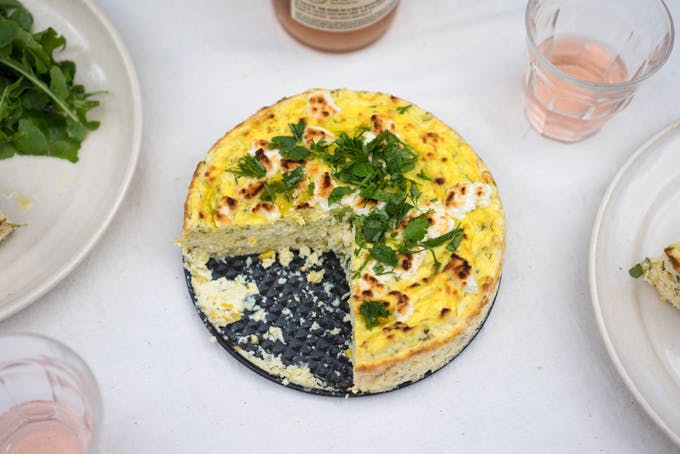Homemade Ricotta Recipe
So simple, a fresh ricotta recipe should be part of every cook's repertoire. Made from just two ingredients - buttermilk and whole milk.

A good, fresh ricotta recipe should be part of every cook's repertoire. That being said, somehow, four or five years have passed since I last made fresh ricotta in my own kitchen. I used to make it often in my old apartment in the Western Addition neighborhood of San Francisco. The gem of that particular apartment was a beautiful, white, four-burner, vintage Wedgewood stove placed centrally upon a floor made of black-and-white checked linoleum. No one with good conscience could have lived in that apartment and not put that stove to good use. Unfortunately the love affair was short-lived, she was afflicted with slow-gas leak, PG+E condemned her, and she would have to be replaced - unfortunately with something new and shiny, and without nearly as much character.

Ricotta is traditionally made from the whey left over from cheesemaking - from the whey of buffalo mozzarella, sheep's milk pecorino, etc. For those of us without access to cheesemaking by products, delicious fresh ricotta can also be made by using readily available cow's milk - or a blend of cow and goat milk. You will be surprised at how easy it is, and making riotta doesn't requite any special cheesemaking ingredients like, for example, rennett. Give it a go.
Ricotta tastes and smells like the milk it is made from, so use the best and freshest dairy you can find. You can control the consistency of your cheese by the length of time you drain it - for a drier ricotta drain for 15 minutes or more, for a ricotta that is a bit creamier, drain for less.
Homemade Ricotta Recipe
You can use fresh ricotta for a many things, last night I used it in a favorite thousand-layer lasagna I make by rolling out fresh pasta into parchment-thin sheets. I usually salt it if I am going to use it for savory applications - spreads, pasta stuffings, casseroles, etc. For sweet applications I might salt just a touch, and then taste as I go - you can drizzle it with honey and pair with berries - and it works wonderfully as a base for all kinds of desserts and baked goods.
1 gallon good-quality whole milk
1 quart good-quality buttermilk
Combine both milks into a large nonreactive saucepan over medium high heat, preferably a thick-bottomed pan if you have one. You will need to stir occasionally, scraping the pan bottom, to avoid scorching. Once the milk is hot, stop stirring. You will start to see curds rise and come to the surface. Run a spoon or spatula along the bottom of the pan occasionally to free up any stuck curds.
While the milk is heating, select a sieve or colander with a wide surface area. This will help your curds cook more quickly. Line the colander with a large piece of cheesecloth that has been folded numerous times - until you have about 5 or six layers. Place the lined colander over a large bowl or sink.
When the mixture reaches about 175F degrees, you will see the curds and whey seperate. The curds are the clumpy white mass. Now, remove the pan from heat, and gently begin to ladle curds into the prepared sieve. Pull up on the sides of the cheesecloth to drain off any extra liquid, but resist pressing on the curds. Gather the edges of the cloth, tie or fasten them into a knot and allow them to drain for another 15 minutes minimum. Move to an airtight container and refrigerate if you aren't going to use it immediately. Try to use or eat it within a few days, it really is best that way.
Makes about 4 cups.



Comments are closed.
Apologies, comments are closed.
Comments
This is my first time posting here but I have been admiring this site for a while.
I enjoyed reading your recipe for ricotta. Although I’ve tried making my own creme fraiche it never ocurred to me to make ricotta at home.
The picture of 1000 layer lasagne is mouth-watering. I can’t wait till you post the expanded recipe!
Hi Heidi, Wonderful site. Thanks.
Do you throw away the whey or use it in some other receipes which require use of water. By itself the drained whey does not taste that good but it contains lot of minerals. I remember my mom used drained whey in lieu of water in cooking vegetables or rice etc.
ricotta plays a very important part in italian cuisine!
Clotilde – I’m glad you liked it. Yours looks nice and moist – prob. from the slow drain of the dishtowel 🙂 I’ve been salting my ricotta a bit at a time as I ladle it with a slotted spoon from the big pot. I try to be nice to the curds, so I gently turn them over once or twice to incorporate the salt before tying up the cheesecloth.
Sally, My understanding is that you can’t make more ricotta from whey leftover from making an acid (activated) cheese.
Can you make more cheese from the whey byproduct of this cheese? Would you simply add buttermilk to it and repeat the process?
I held a “cooking class” with my six-year-old daughter last night and made pizza with this cheese. She thought the formation of the curds was a fascinating process. I stuck my pizza stone on the grill and topped four-inch circles with sauce, thin slices of ricotta, mushroom blend and three-color bell peppers. Fantastic stuff. I also make homemade lasagna noodles but have found we like a thicker, hearty noodle with either fresh spinach juice or pureed red bell peppers added to the noodle dough for color and taste. I may never go back to that rubber cement ricotta again.
Heidi – I tried it and it worked beautifully, easy and delicious, thank you so much! One question: at which point do you salt your ricotta? When you make it, or when you use it?
Just got back from Italy and fell in love with their sweetened Ricotta used in desserts. Will have to try and recreate some of that — thanks for the instruction!
Hi Heidi,
thanx for the recipe and the beautiful pictures (as usual).
It’s very usefull to have an easy recipe to make fresh ricotta because *good* fresh ricotta is hard to find. I already found one that was good, but the taste of goat cheese was definitly too strong. So now i can make make mine using the milk i want.
I think im gonna try homemade mascarpone too.
Love
Fanny
My mom taught me how to make Ricotta this way many years ago. She learned this technique from her mother who came from Italy in the early 1900’s. While it is true that Ricotta is not made this way at the dairy how many of us have access to whey leftover from cheese making? The result is the same.
Thanks for your wonderful website. I am having so much fun with it. I can hardly wait to try the ricotta with my lasangna and cheese cake. Thanks.
What’s kefir?
Before I google, thought I’d ask a few “experts.”
Thanks!
I am already a convert to thousand-layer lasagne, and I have never tried it! I look forward to seeing the recipe sometime!
Clotilde – Do you have a pair of fresh tights or (god-forbid) nylons around? In a pinch I might cut up a pair and stretch them across a colander or fine-meshed strainer and try that for starters.
Oh, this sounds like the *perfect* use for the bottle of farm-fresh milk I got for my birthday! I don’t have cheesecloth though, would a simple dish cloth work you think? Thanks, as always, for the inspiration!
I agree with Antonietta – your photos are absolutely beautiful – and so well-styled – are you a photographer? If not, you should be!
Hi I’m new to your blog and I just wanted to say WOW your photos are gorgeous!
I love ricotta!!!
Thanks heaps 🙂
Thanks for the recipe. I make a variety of dishes with half ricotta and half cottage cheese because the ricotta is so “rubbery” as you put it. I can’t wait to try this, I’m sure I’ll be using all ricotta in the future. I had no idea it was so easy to make.
Ciao Heidi!
It’s difficult to find fresh ricotta here in Germany — unless you go to a highly overpriced Italian “specialty” store, and even then I sometimes end up with a pre-packaged kind. (Although, I can drive to Italy in a little over 2 hours … but it might hold dinner up a bit [and fuel prices — ei-ei-ei!].)
I didn’t realize it was so uncomplicated. Thanks for this recipe — now I can make it myself. Power to the people! 🙂
Thanks for reminding me. I used to make a shrimp/ricotta/tomato sauce/parmesan lasagna that is a variation on your theme with the super-thin, homemade lasagna noodles. They are so much more delicate than the boxed noodles. Now I can make it with homemade ricotta….thanks
Hi Heidi – this looks/sounds so good, I’ll definitely try it soon. I made mascarpone the other day and it tasted really nice too.
Wow, that’s it? What an easy recipe! Now I don’t have to wait for ricotta to go on sale! I think I’ll use it in ricotta cheesecake or just eat it plain with honey and dried fruit.
Abby – You might be better off exploring some of the different nut ‘cheese’ recipes out there – I’ve had quite a few that are delicious, and sometimes I even prefer them for certain applications over dairy based cheese. Raw+vegan cookbooks are a good place to start.
Jessica, the quick and dirty answer re: the thousand-layer lasagne. I rolled out homemade pasta dough extra-thin, pre-cooked it for a minute, scooped the noodles from the boiling salted water and dunked them in a big bowl of cold water that had a splash of oil in it. In a buttered casserole dish I would do a layer of fresh pesto, a single layer of noodles, a layer of cheese and pesto, a layer of noodles, a layer of pesto, a layer of cheese, and on and on. I do all sorts of variations on this lasagne with different kinds of cheeses and sauces. It is my favorite, but a huge time commitment. At some point I’ll do a proper write-up of the recipe. Consider yourself warned though – it is hard to go back to thick lasagne noodles after you have had a lasagne this way.
Hi Heidi-
I’ve been dying to try homemade ricotta, just needed a little inspiration! Your thousand layer lasagna (I’m assuming that’s it in the picture) looks scrumptious….and is all the inspiration I’ll need! It looks like there are herbs, or spinach in the dough?? I’d love to know how you make it.
This may be a silly question … but can it be made without using cow’s milk? I can’t digest lactose … and while I know that cheese has little lactose, it’s usually aged cheese that doesn’t. I know I can’t handle cheese from cow’s milk so …
Just thought I’d ask … for anyone who might have an idea. Lactose-intolerance REALLY knocks out a lot of food/recipes for me so any substitution is always a plus. Thanks!
I am DEFINITELY trying this! Thanks
Comments are closed.
Apologies, comments are closed.
More Recipes
Weekly recipes and inspirations.
Popular Ingredients